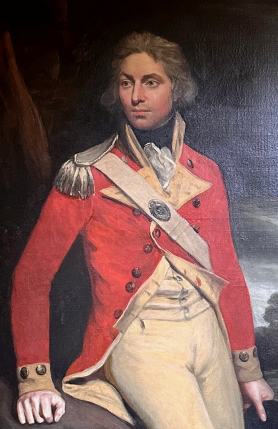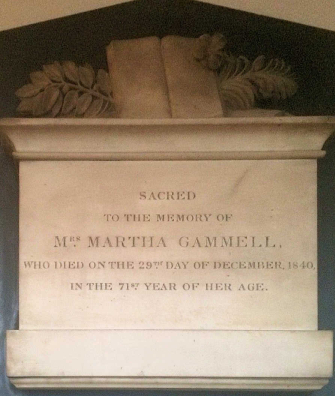Lt Gen Andrew Gammell
1764–1815
Andrew Gammell was the elder of the two surviving, sons of James Gammell, Banker, of Greenock, and his wife Janet Geils. He was born in Greenock on 19 January 1764, and his baptism is recorded in the Parish Register of Greenock West on 20 January, under the name of Andrew Gemmel. With his younger brother William, he attended Greenock Grammar school, and is known to have been a pupil there in 1772.
We cannot trace anything about Andrew's career for the years immediately after he left school, but we know that he was involved in the Greenock Bank, since he resigned, along with his father, from the Bank’s partnership on 7 July 1813.

By the late 1780s, that is when he was in his mid-twenties, he had established himself in London, and it is possible that he was working in the office of Sir William Kay's bank in the City, which firm were the agents in London for his father's bank in Greenock, but there is no firm evidence of this.
He had also set up house with Martha Stageldoir. She was almost certainly one of “The three Miss Stageldoirs” (Mary, Martha and Jane), who in the 1780s and early 90s, were well-known dancers, singers and minor actresses in the London theatre. There are however some unexplained discrepancies. The Miss Stageldoirs’ father was John Stageldoir (according to A Biographical Dictionary of Actors, Actresses, Musicians, Dancers, Managers & Other Stage Personnel in London, 1660 – 1800), whereas Martha Stageldoir’s father (as far as can be traced in Ancestry.com) was called Joseph. Moreover, John Stageldoir’s three daughters (“The three Miss Stageldoirs”) were Mary, Martha and Jane, whereas Joseph Stageldoir had three daughters, Sarah, Jane and Martha. A Joseph Stageldoir died in September 1806 as did (an un-named) Stageldoir who was a “property-man of Drury Lane theatre” - who can surely only have been John. So on balance, Stageldoir is such an unusual name, and the coincidence of both fathers having three daughters, two of whom were identically named, and both dying at the same time, makes it seem certain that John and Joseph must have been one and the same person, with John just being the stage name for Joseph, and likewise Sarah using the stage name Mary.
The next unknown is whether Andrew ever married Martha Stageldoir. In my view probably not, since no record of a marriage has been found, and in his will, he leaves a limited bequest of an annual allowance for life “to my dear friend Martha Stageldoir, named Mrs Gammell”. This is surely not phrasing he would have used to write a bequest to his lawful wife. Whatever the situation, she was clearly living with him as his wife and was known as Mrs Gammell, as is evidenced not only in his will, but also in other records, such as on the baptism record of their eldest son William Gammell, who was described as 'son of Andrew and Martha Gammell', Martha's death certificate, on which she is described as 'widow of Lt. General Gammell', and on the memorial to her in St Luke and Christ Church, Chelsea, which describes her as Mrs Martha Gammell.
Andrew and Martha had a large family as follows:
|
|
Born |
Died |
|
30 September 1789 |
21 February 1853 |
|
|
11 January 1791 |
8 February 1871 |
|
|
26 May 1792 |
4 June 1828 |
|
|
3 January 1797 |
23 September 1893 |
|
|
1799 |
23 March 1872 |
|
|
3 January 1801 |
14 March 1861 |
|
|
12 October 1803 |
18 March 1883 |
|
|
27 January 1808 |
23 February 1855 |
In January 1794, Andrew joined the Army. Just why is not clear, but there was much patriotic feeling around at that time, and the Napoleonic Wars were on the verge of breaking out. He may also have been looking for a more adventurous life and an income independent of his father, who may well have been displeased with his matrimonial affair in London.
By April 1894 he was appointed a Captain in the 81st Foot, with whom he served in England and in Ireland and in October 1794 he transferred to the 104th Regiment (The Royal Manchester Volunteers) and became a Major. In 1795 he became Lt. Colonel in the same regiment. Shortly after this, the Regiment was disbanded, and Andrew took leave of absence at the beginning of 1896 to visit Europe in the hope of joining the army of the Grand Duke Charles of Austria, who was fighting the French. He was unsuccessful however in that respect, as volunteers were no longer acceptable, but he was able to be a spectator of most of the operations against the French in that year, and returned to England carrying important despatches, when the year's campaigning ended in the autumn. Among the despatches he brought home were some for H.R.H. The Duke of York, at that time Commander-in-Chief of the British Armed Forces and it seems fair to assume that Andrew became a friend of the Duke through the influence of Lord Elgin, who was responsible for selecting Andrew to carry the despatches referred to back to England.
On his return from Europe, Andrew seems to have been unemployed but on full pay for several years, although there is some evidence that he acted for a time as A. D. C. to the Duke of York. In 1799 he was appointed a Lieut-Col in a Fencible Regiment, and in 1800 was made a full Colonel in The Edwards Fencibles a volunteer Regiment, but in 1801 he was again unattached and was on half pay until the autumn of 1803. During this period he is referred to in Army Lists as 'late 91st Foot' or The Argyllshires, raised in 1794, but the Regimental records contain no trace of his serving with them, so his connection, if any, with the Argylls remains a mystery.
In September 1803, Andrew was appointed to the 1st Foot or Grenadier Guards. At that time not only was the Duke of York Army Commander in Chief, but he was also Colonel of the Grenadiers, and it is fair to speculate that the Duke was behind the appointment. Andrew's military record from then on, taken from Grenadier Guards records is as follows:
Sept 1803 Colonel in 3rd Battalion at Chatham
Nov 1804 Moved to Deal
May 1805 On staff (appointment unknown)
1806 To Ireland
July 1807 To 3rd Battalion in Sicily
Dec 1807 Returned to UK
Feb 1808 To 2nd Battalion at Westminster
June 1808 Promoted to Major General
Feb 1809 Commander-in-Chief's leave
May 1811 On staff North-west district
Sept 1811 Commander-in-Chief's leave
June 1813 Promoted to Lieutenant General
Jan 1814 Leave
June 1814 Resigned
However, even in November 1814 he was still attending military levees organised for the Duke of York.
It will be seen that from 1805 to 1807 he was on the staff and we know that at some time in his army career he served on the Staff as Brigadier General in England and Ireland. Again from 1809 to 1814 he almost continuously enjoyed 'Commander-in-Chief's leave'. What this means neither the Guards nor we know, but as family tradition is that he spent his time in riotous living at the expense of his father, it is tempting to think that these periods of 'leave' were in fact leave on full pay, dancing attendance on his friend the Duke of York. Biographies of the latter show that throughout this period he was living a dissolute life in London, or at his country house at Oatlands near Weybridge 'gambling and drinking with a house full with his friends'; but from enquiries made, no reference to Andrew has been noted in the Duke’s papers.
What exactly happened to Andrew after his retirement in 1814 is unknown, but his resignation from the Army could have been due to ill-health, as he died at Southampton Place, New Road, Bloomsbury on 14 October 1815 at the early age of fifty-one. He was buried in the South Cloister of Westminster Abbey - why no one really knows, since it is clear from what has been written above, that he had in no way a distinguished military career.
There is no stone or memorial to mark the site of his grave in the Abbey, so the exact site cannot be ascertained, but the following appears in the Funeral Fee Book of the Abbey:
'Total expenses £19.10.0, made up of Fees, grave expenses and decorations of which £4.0.10 was paid to Mr. Catling the Verger and £3.13.3 for decorations.' 'The service was conducted by the Revd. Dr. William Whitfield Dakins, and the Chanter and Undertaker was S. Chittenden of 40 Greek Street, Soho Square.' N.B. Fees were paid for the ground, to the Chanters, the Sacrists and Vergers, the four Bellringers, the Clerk of Works, the Mason, the six bearers, the two Porters for the Pall, for a leaden coffin and for tolling the bell. Decorations were payments made to the Receiver, Clerk of Works, Chanter and the Porter.
In his will, made in January 1814, and proved by Sir William Kay, Bart., Banker of London, in December 1815, Andrew bequeathed 'to my dear friend Martha Stageldoir named Mrs. Gammell' £300 per annum, to a daughter of his (Jessie) who had disgraced herself by marrying a 'blackguard' only £100 per annum for her life, with all the rest of his personal and heritable property to be divided between his other seven children.
Martha Stageldoir/Gammell outlived her husband by over twenty-five years. She died at Harrow Lodge, Hampstead on 29 December 1840, and is buried in St Luke's, Chelsea, which also has a memorial plaque in her memory. That plaque and her death certificate both record her name as Martha Gammell.

